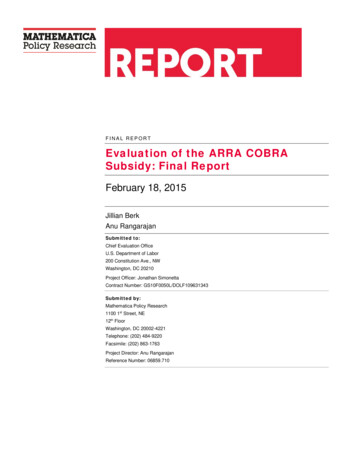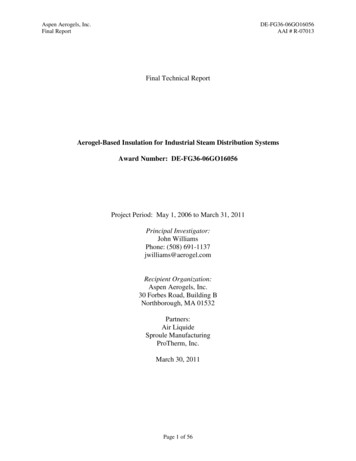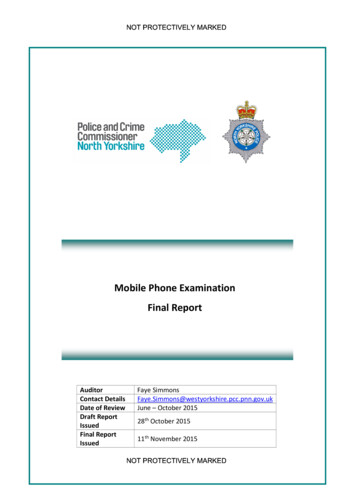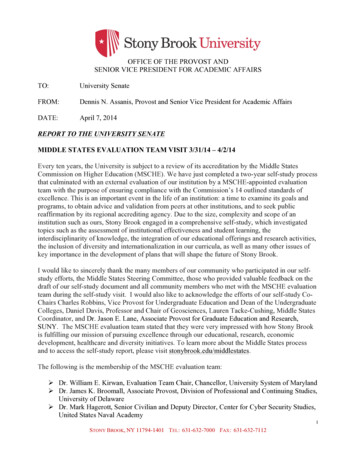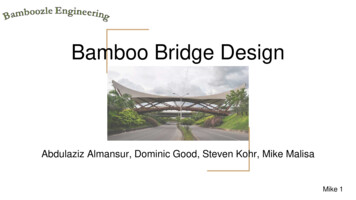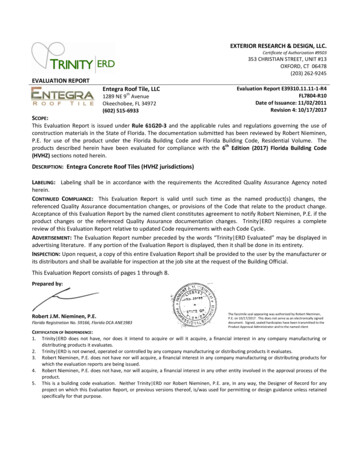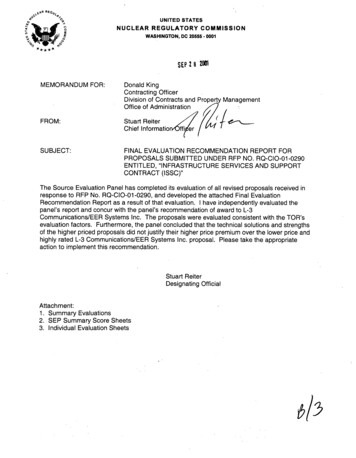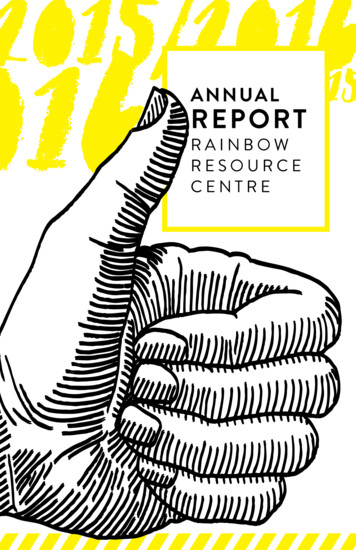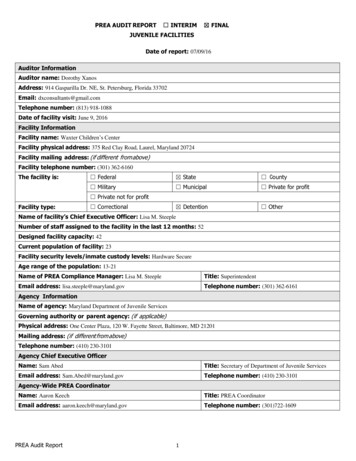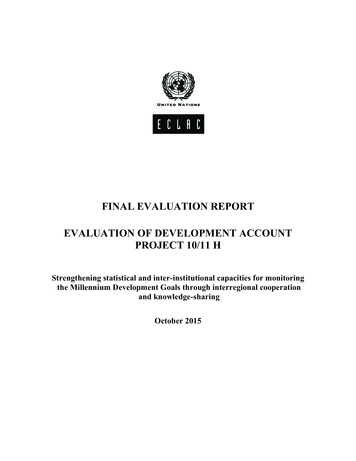
Transcription
FINAL EVALUATION REPORTEVALUATION OF DEVELOPMENT ACCOUNTPROJECT 10/11 HStrengthening statistical and inter-institutional capacities for monitoringthe Millennium Development Goals through interregional cooperationand knowledge-sharingOctober 2015
This report was prepared by Carlos Rodríguez Ariza, an external consultant, who led the evaluation.Mr. Rodriguez Ariza worked under the overall guidance of Raúl García-Buchaca, Chief of the ProgrammePlanning and Operations Division of the Economic Commission for Latin America and the Caribbean (ECLAC),and Sandra Manuelito, Officer-in-Charge of the Programme Planning and Evaluation Unit, and under the directsupervision of Irene Barquero, Programme Officer of the same unit, who provided strategic and technicalguidance, coordination, and methodological and logistical support. The evaluation also benefited from theassistance of María Victoria Labra, Programme Assistant, and Carolina Trajan, Unit Intern, also of theProgramme Planning and Evaluation Unit.The evaluation team is grateful for the support provided by its project partners at ECLAC and the otherUnited Nations regional commissions, all of which participated in the implementation of this project and wererepresented in the Evaluation Reference Group. Warm thanks go to the programme managers of the StatisticsDivision of ECLAC for their cooperation throughout the evaluation process and their assistance in the review ofthe report, in particular Daniel Taccari, Statistician, and Pauline Stockins, Consultant. The team also extends itsgratitude to the programme managers of the other United Nations regional commissions who participated in thisevaluation, including Fatouma Sissoko, Gender Statistics Specialist, Demographic and Social Statistics Section,Economic Commission for Africa (ECA); Yanhong Zhang, Chief of the Population & Social Statistics Section,Statistics Division, Economic and Social Commission for Asia and the Pacific (ESCAP); Neda Jafar, Head of theStatistical Policies and Coordination Unit, Economic and Social Commission for Western Asia (ESCWA); andTaeke Gjaltema, Statistician, Statistics Division, Economic Commission for Europe (ECE).All comments on the evaluation report by the Evaluation Reference Group and the evaluation team ofthe Programme Planning and Evaluation Unit were considered by the evaluator and duly addressed in the finaltext of the report, where appropriate. The views expressed in this report are those of the author and do notnecessarily reflect the views of the Commission.The annexes to this evaluation report have been reproduced without formal editing.Copyright United Nations, October 2015. All rights reservedPrinted at United Nations, SantiagoS.15-01227
FINAL EVALUATION REPORTTABLE OF CONTENTSACRONYMS . viiEXECUTIVE SUMMARY . ix1. INTRODUCTION . 12. BACKGROUND OF THE PROJECT. 12.1. BACKGROUND OF THE PROJECT . 12.2. PROJECT STRATEGY . 22.3. THE COMPLEXITY OF THE INTERVENTION . 22.3.1 THE PARTICULARITIES OF A DEVELOPMENT ACCOUNT PROJECT . 22.4. THE LOGIC OF THE INTERVENTION . 32.4.1. THEORY OF ACTION . 32.4.2. THEORY OF CHANGE . 33. EVALUATION METHODOLOGY . 83.1. METHODOLOGY USED AND DATA COLLECTION INSTRUMENTS . 83.1.1. METHODOLOGICAL APPROACH AND DESIGN FOR THE PURPOSE OF THE EVALUATION . 83.2. LIMITATIONS OF THE EVALUATION . 94. EVALUATION RESULTS .104.1. COHERENCE AND RELEVANCE OF THE PROGRAMME . 104.1.1. RELEVANCY AND ALIGNMENT . 104.1.2. COMPLEMENTARITIES AND SYNERGIES WITH OTHER WORK . 154.2. EFFICIENCY OF PROGRAMME MANAGEMENT . 174.2.1. PROJECT GOVERNANCE AND MANAGEMENT . 174.2.2. COLLABORATION AND COORDINATION MECHANISMS . 184.2.3. IMPLEMENTATION OF ACTIVITIES IN A TIMELY AND RELIABLE MANNER, ACCORDINGTO THE PRIORITIES ESTABLISHED BY THE PROJECT DOCUMENT. 214.3. PROJECT EFFECTIVENESS.244.3.1. CONTRIBUTION OF THE PROJECT TO THE ACTIVITIES, GOALS AND OBJECTIVES OUTLINED INTHE PROJECT DOCUMENT . 244.3.2. BENEFICIARIES’ PERCEPTIONS OF PROJECT ACTIVITIES WERE POSITIVE . 394.3.3. THE INFLUENCE OF THE PROJECT IN THE LONG TERM AND AT THE POLICY LEVEL . 454.4. SUSTAINABILITY .484.5. CROSS-CUTTING ISSUES .524.5.1. GENDER AND HUMAN RIGHTS. 524.5.2. QUALITY OF THE MONITORING, EVALUATION AND KNOWLEDGE MANAGEMENT SYSTEM . 535. CONCLUSIONS . 565.1. PROGRAMME DESIGN .565.2. RELEVANCE .565.3. EFFICIENCY .57iii
FINAL EVALUATION REPORT5.4. EFFECTIVENESS .585.5. SUSTAINABILITY .595.6. CROSS-CUTTING APPROACHES: GENDER, MONITORING AND KNOWLEDGE MANAGEMENT .595.6.1 GENDER AND HUMAN RIGHTS. 595.6.2 MONITORING AND KNOWLEDGE MANAGEMENT . 606. LESSONS LEARNED . 626.1. FOR IMPROVING THE DESIGN AND INCEPTION PHASES OF INTERREGIONAL PROJECTS.626.2. FOR IMPROVING MONITORING AND REPORTING . 626.3. FOR BETTER CONSIDERATION OF THE IMPLICATIONS OF AN INTERREGIONAL PROJECTIN TERMS OF ORGANIZATION, GOVERNANCE, COORDINATION, COLLABORATION ANDFINANCIAL MANAGEMENT .626.4. FOR IMPROVING THE DEVELOPMENT OF EXIT STRATEGIES, KNOWLEDGE MANAGEMENT ANDKNOWLEDGE-SHARING AT THE ACTIVITY AND PROJECT LEVELS TO ENSURE SUSTAINABILITY .637. RECOMMENDATIONS .647.1. IMPROVE THE DESIGN OF INTERREGIONAL PROJECTS . 647.2. DEVELOPMENT OF BETTER IMPLEMENTATION PLANS . 657.3. IMPROVEMENT OF MONITORING AND REPORTING. 667.4. BETTER CONSIDERATION OF THE IMPLICATIONS OF AN INTERREGIONAL PROJECT IN TERMSOF ORGANIZATION, GOVERNANCE, COORDINATION, COLLABORATION ANDFINANCIAL MANAGEMENT .687.5. IMPROVEMENT OF EXIT STRATEGIES, KNOWLEDGE MANAGEMENT AND KNOWLEDGE-SHARINGAT THE ACTIVITY AND PROJECT LEVELS TO ENSURE SUSTAINABILITY . 697.6. BETTER INTEGRATION OF GENDER THROUGHOUT THE PROJECT CYCLE. 71ANNEXES.73ANNEX 1: TERMS OF REFERENCE OF THE EVALUATION . 74ANNEX 2: LIST OF WORKSHOPS, PUBLICATIONS, EVENTS, TAMS AND PARTICIPANTS . 88ANNEX 3: LIST OF PERSONS INTERVIEWED . 109ANNEX 4: SURVEY QUESTIONNAIRE ONLINE. 115ANNEX 5: BIBLIOGRAPHY . 147ANNEX 6: BACKGROUND OF THE METHODOLOGY AND FINDINGS OF THE EVALUATION. 148ANNEX 7: EVALUATOR’S REVISION MATRIX . 224iv
FINAL EVALUATION REPORTList of TablesTABLE 1INTENDED THEORY OF CHANGE OF THE PROJECT . 4TABLE 2EXPECTED CHANGES AND ACCOMPLISHMENTS . 6TABLE 3GAPS IN THE THEORY OF ACTION . 7TABLE 4CONTENT OF THE SUBPROGRAMMES RUN BY THE REGIONAL COMMISSIONS.14TABLE 5DILEMMAS OF THE INTER OR INTRA-REGIONAL MODEL OF PROJECT IMPLEMENTATION .15TABLE 6DEGREE OF IMPLEMENTATION OF THE THEORIES OF ACTION AND CHANGE . 27TABLE 7NUMBER OF PROJECT OUTPUTS .29TABLE 8OUR PROGRAMME THEORY STARTS WITH THE LAST EA .30TABLE 9LEVEL OF IMPLEMENTATION OF THE PROJECT’S THEORY OF ACTION . 31TABLE 10 MULTIPLIER EFFECTS OF THE PROJECT. 46List of FiguresFIGURE 1COMPONENTS OF THE PROGRAMME THEORY: THEORY OF ACTION . 3FIGURE 2THEORY OF CHANGE . 6FIGURE 3PROGRAMME THEORY . 9FIGURE 4MAP OF UNITED NATIONS FRAMEWORK FOR MONITORING MDG PROGRESS .11FIGURE 5PERCEPTIONS OF THE REGIONAL COMMISSION STAFF .20FIGURE 6FRAMEWORK OF ACTIVITIES TO BE LINKED TO ACHIEVE THE PROCESSES THAT WILL LEADTO THE RESULTS .24FIGURE 7LIMITS TO THE PROJECT’S INFLUENCE. 25FIGURE 8PROCESS OF CHANGE FROM CHANGES IN PERCEPTION, TO CHANGES IN ATTITUDE,APTITUDE AND BEHAVIOUR AT THE PERSONAL AND/OR INSTITUTIONAL LEVEL.26FIGURE 9PERCEPTION OF THE USEFULNESS OF SEMINARS BY BENEFICIARIES .40FIGURE 10 LEVEL OF AGREEMENT OR DISAGREEMENT WITH THE FOLLOWING STATEMENTS .42FIGURE 11 HOW WOULD YOU ASSESS THE QUALITY OF THE TECHNICAL ASSISTANCE PROVIDEDIN TERMS OF THE SUBSTANTIVE CONTRIBUTIONS RECEIVED AND THEIR USEFULNESS FORYOUR AREA OF WORK? .43FIGURE 12 HOW WOULD YOU RATE THE USEFULNESS OF THE TECHNICAL ASSISTANCE PROVIDEDIN TERMS OF THE SUBSTANTIVE CONTRIBUTIONS TO INCREASING THE AVAILABILITY OFUP-TO-DATE AND COMPARABLE MDG DATA FOR YOUR COUNTRY? . 44FIGURE 13 REPLICATION OF THE INTERVENTION MODEL AS A WAY TO MAKE THE PROJECT SUSTAINABLE.50v
FINAL EVALUATION REPORTACRONYMSAcronymDefinitionBPBest practicesCELADELatin American and Caribbean Demographic CentreCRVSCivil registration and vital statisticsDADevelopment AccountDESAUnited Nations Department of Economic and Social AffairsDevInfoDatabase system developed under the auspices of the United NationsEAExpected AccomplishmentECAEconomic Commission for AfricaECEEconomic Commission for EuropeECLACEconomic Commission for Latin America and the CaribbeanERGEvaluation Reference GroupESCAPEconomic and Social Commission for Asia and the PacificESCWAEconomic and Social Commission for Western AsiaFGDFocus group discussionIAEGInter-Agency Expert Group on Millennium Development Goal indicatorsICTInformation and communications technologyILOInternational Labour OrganizationIoAIndicator of AchievementLFALogical Framework ApproachMDGMillennium Development GoalNGONon-governmental organizationNSONational statistical officePPEUProgramme Planning and Evaluation Unit (ECLAC)PPODProgramme Planning and Operations Division (ECLAC)PRODOCProject documentRCRegional CommissionSDGSustainable Development GoalSDMXStatistical Data and Metadata eXchangeSSISemi-structured interviewsTAMsTechnical advisory missionsToRTerms of referenceUNUnited NationsUNCTADUnited Nations Conference on Trade and DevelopmentUNDGUnited Nations Development GroupUNEGUnited Nations Evaluation Groupvii
FINAL EVALUATION REPORTEXECUTIVE SUMMARYI.The present document is the evaluation report of the Development Account (DA) project“Strengthening statistical and inter-institutional capacities for monitoring the Millennium DevelopmentGoals through interregional cooperation and knowledge-sharing” (ROA 146). This project focuses onincreasing the availability of up-to-date and comparable Millennium Development Goal (MDG) dataat the national, regional and global levels. The project was approved under Development AccountTranche 7 and covered a period of approximately four years (2011-2014). It was implemented bythe five United Nations regional commissions: Economic Commission for Latin America and theCaribbean (ECLAC) as the lead agency, Economic Commission for Africa (ECA), Economic Commissionfor Europe (ECE), Economic and Social Commission for Asia and the Pacific (ESCAP), and Economic andSocial Commission for Western Asia (ESCWA).II.This is an evaluation managed by the Programme Planning and Evaluation Unit (PPEU) of theProgramme Planning and Operations Division (PPOD) of ECLAC and implemented by the externalevaluator Carlos Rodríguez Ariza from March 2015.III.The objective of this evaluation is to assess the efficiency, effectiveness, relevance, and sustainability(evaluation criteria) of project implementation and, in particular, to document the results of the projectin relation to its overall objectives and expected results as defined in the project document.Additionally, the evaluation identified good practices and lessons learned, both of which can be usedwhen designing similar interventions in the future.IV. The evaluation employed a mixed methodology of quantitative and qualitative research tools in anintegrated design to enrich the process, and provided more insightful understanding. The evaluatorapplied the traditional evaluation tools in this order: (a) the desk review (qualitative) consisted of ananalysis of associated project documents to extract information and an overview of the processespromoted before conducting the evaluation fieldwork; (b) semi-structured interviews (qualitative), thatis, individual meetings in which the interviewer applied a framework of themes to explore the issues inan open way, thus allowing the interviewee to bring up new ideas and approaches; (c) focus groupdiscussion guides (qualitative) to lead meetings with groups of people who were involved in this oranalogous project activities and/or have a similar professional profile in an open way so as toprompt debate on relevant issues; and (d) self-administered surveys (quantitative) usingquestionnaires (sets of questions with closed and open answers).V.The evaluation sources included 5 regional commissions, 65 surveys, 52 interviews (28 face-to-faceand 24 carried out remotely by Skype/phone), 2 focus groups, 2 closing workshops (one at each sitevisited), and 2 site visits, involving a visit to Santiago, Chile and the case studies of two regions (firstcase study ECLAC, Chile and Argentina) and second case study (ESCWA, Lebanon and Jordan).VI. A number of potential limitations, assumptions and constraints were identified at the inceptionstage. In most cases, these were addressed or mitigated with the support of the evaluationmanagement and by triangulating information gathered from various sources in order to providestronger evidence-based conclusions.VII. Conclusions: The conclusions are divided into sections related to the evaluation criteria and theevaluation questions around project design, relevance, efficiency, effectiveness, sustainability andcross-cutting issues.(a) Programme design: The project's programme theory was appropriate and relevant ingeneral terms, but it could have been more defined, explicit, clear and better linked after thedesign and inception phases.ix
FINAL EVALUATION REPORT(b) Relevance: Although there are areas for improvement, in general the project was relevantand was aligned with global problems, regional and country needs, the regional commissions,the United Nations and the Development Account. The project could have been more relevant,especially at the interregional level. Its design was vague and it was primarily implementedon the basis of the ongoing subprogrammes. One of the main reasons behind the weakinterregional approach was that a top-down approach was used, more supported by UnitedNations Headquarters than by the regional commissions, and the time frame was too short forit to be properly owned by the regional commissions. There were complementarities andsynergies with other projects and programmes.(c) Efficiency: Project management was good, but project governance left room for improvement, andthis affected knowledge-sharing. Collaboration and coordination mechanisms left room forimprovement. Given the scale of the challenges, activities were implemented in a reasonable timelyand reliable manner, according to the priorities established by the project document.(d) Effectiveness: The project contributed to expected and unexpected results, and in generalwas effective in terms of completing the activities and in terms of contributing to the goals andobjectives outlined in the project document.(e) Sustainability: The project is sustainable even if the challenges remain. At the design stage,some elements that would have contributed to sustainability were omitted while other elementswere devised but not implemented.(f) Cross-cutting approaches: Gender and human rights and knowledge management There was no common cross-cutting gender perspective. Monitoring presented somechallenges related to (i) the need to be less activity- and data-focused and more focusedon analysis; and (ii) the lack of capacity for monitoring and the use and sharing of theresulting knowledge. The progress reports were accurate but failed to capture existing information regardingthe quality of the events, such as workshops. The project did not have a formal and explicitexit strategy or a knowledge-sharing strategy. It did not generate enough opportunitiesfor sharing its achievements and experiences among the regional commissions.VIII. Lessons learnt. The evaluation also reveals some lessons learnt that could be useful for the followingpurposes: (a) to improve the process of design and inception of interregional projects; (b) to developbetter implementation plans; (c) to improve monitoring and reporting; (d) for better consideration ofthe implications of an interregional project in terms of organization, governance, coordination,collaboration and financial management; and (e) to improve the development of exit strategies,knowledge management and knowledge-sharing.IX. Recommendations. There are six recommendations arising from this evaluation that are explained inmore detail in the main report and which highlight the priorities, those in charge and some possibleelements of an action plan for the management response. These recommendations relate to: (a)improving the process of designing interregional projects; (b) developing better implementationplans; (c) improving monitoring and reporting; (d) better consideration of the implications of aninterregional project in terms of organization, governance, coordination, collaboration and financialmanagement; (e) improving exit strategies and knowledge management at the activity and projectlevels to ensure sustainability; and (f) better integration of gender throughout the project cycle.x
FINAL EVALUATION REPORT1. INTRODUCTION1.This document is an end-of-cycle evaluation of an interregional project that focuses on increasing theavailability of up-to-date and comparable Millennium Development Goal (MDG) data at thenational, regional and global level. This is an evaluation managed by the Programme Planning andEvaluation Unit (PPEU) of the Programme Planning and Operations Division (PPOD) of ECLAC andcarried out by the external evaluator Carlos Rodríguez Ariza.2.The unit of analysis or object of study for this evaluation is the project “Strengthening statistical andinter-institutional capacities for monitoring the Millennium Development Goals through interregionalcooperation and knowledge-sharing” (ROA 146). It is understood as the set of components, outcomes,outputs, activities and inputs that were detailed in the project document and the associatedmodifications made during implementation.3.The objective of this evaluation is to assess the efficiency, effectiveness, relevance, and sustainability(evaluation criteria) of project implementation and, in particular, to document the results of the projectin relation to its overall objectives and expected results as defined in the project document.Additionally, the evaluation process identified good practices and lessons learned, both of which canbe used when designing similar interventions in the future.4.The evaluation process comprised a global analysis involving desk review and surveys combined witha visit to Santiago/Chile and case studies of two regions (first case study ECLAC-Chile and Argentinaand second case study ESCWA –Lebanon and Jordan).2. BACKGROUND OF THE PROJECT2.1. BACKGROUND OF THE PROJECT5.The need to monitor progress towards the Millennium Development Goals has provided anopportunity for many developing countries in different regions to develop their statistical systems andproduce better information in support of evidence-based policies for development. Nevertheless, asthe period assigned for the achievement of the Millennium Development Goals was almost over,developing nations faced pervasive statistical challenges in monitoring them. These included persistentdata gaps, insufficient use of the official national data produced by both the national agency incharge of the national Millennium Development Goal reports, as well as by the internationalagencies; and the statistical discrepancies among indicator values produced or compiled by national,regional and international sources. These issues are of great concern in the international community,particularly within the statistical and reporting communities in developing countries. The statisticalcommissions and other regional statistical bodies (such as the Statistical Conference of the Americas)have formally recognized these problems and have urged stakeholders to take immediate action tofind solutions. Key points have included strengthening statistical capacities for data and metadataproduction, and improving statistical information exchange among international agencies anddeveloping countries, as recommended in 2007 by the Statistical Commission (E/CN.3/2007/13).6.The entire United Nations system has prioritized these matters, on the premise that there should alsobe more transparency in the way that international agencies use imputed data. The Inter-Agency andExpert Group on Millennium Development Goal Indicators recommended producing detailedexplanations of the difference between global and national monitoring. These included implicationsfor methods and data presentation, and constructing metadata on population estimates used asdenominators to calculate many Millennium Development Goal indicators. The Inter-Agency and1
FINAL EVALUATION REPORTExpert Group has further recommended involving the regional commissions more extensively inreviewing the discrepancies between national and international sources, in assisting in theorganization of data and metadata exchanges between national statistical systems and internationalagencies, and in improving data-sharing at the international level.7.From the regional perspective, responding to the demands of its member countries, the five regionalcommissions have taken on an increasingly active role in strengthening statistical capacities in relationto the Millennium Development Goals in their respective countries and promoting collaborative workwithin countries and regions in order to share experiences and learn from each other. The statisticaldivisions of the regional commissions have been coordinating efforts to resolve data gaps anddiscrepancies between national and international sources. A joint document was presented fordiscussion at the Inter-agen
PRODOC Project document RC Regional Commission SDG Sustainable Development Goal SDMX Statistical Data and Metadata eXchange SSI Semi-structured interviews TAMs Technical advisory missions ToR Terms of reference UN United Nations UNCTAD United Nations Conference on Trade and Development UNDG United Nations Development Group .
